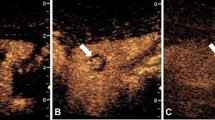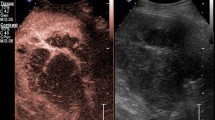Abstract
This review article provides an overview of the use of contrast-enhanced ultrasound (CEUS) in China. Currently, the only licensed contrast agent is SonoVue, a sulfur hexafluoride-filled microbubble contrast agent. In combination with a low mechanical index contrast-specific imaging mode, SonoVue-enhanced CEUS can be used to visualize the micro and macro-vasculature continuously. Since 2004, CEUS has been widely used in China in various clinical scenarios. The authors compared CEUS with baseline ultrasound or contrast-enhanced computed tomography with regard to characterization of focal liver lesions (FLLs). On CEUS, heterogeneous or homogeneous hyperenhancement during the arterial phase and washout in the portal/late phase are typical findings for hepatocellular carcinoma. The enhancement features of intrahepatic cholangiocarcinoma, infected FLLs, focal fatty infiltration, focal fatty sparing, complex cystic FLLs, and uncommon benign FLLs were carefully depicted. CEUS was also used for patient selection in ablation therapy and evaluation of response to ablation for liver cancer. The utility of three-dimensional CEUS of the liver was also explored. In non-liver use, CEUS in hilar cholangiocarcinoma, gallbladder, breast, and prostate was initially investigated. In addition, CEUS was used in interventional procedures such as CEUS-guided hemostatic injection, intraoperative CEUS in neurosurgery, and evaluation of response to high-intensity focused ultrasound ablation of uterine fibroids. The Chinese experience has resulted in increased use of CEUS.







Similar content being viewed by others
References
Claudon M, Cosgrove D, Albrecht T, et al. Guidelines and good clinical practice recommendations for contrast enhanced ultrasound (CEUS)—update 2008. Ultraschall Med. 2008;29:28–44.
Xu HX, Lu MD, Liu GJ, et al. Imaging of peripheral cholangiocarcinoma using low mechanical index contrast-enhanced sonography and SonoVue: initial experience. J Ultrasound Med. 2006;25:23–33.
Xu HX, Liu GJ, Lu MD, et al. Characterization of small focal liver lesions using real-time contrast-enhanced sonography: diagnostic performance analysis in 200 patients. J Ultrasound Med. 2006;25:349–61.
Ding H, Wang WP, Huang BJ, et al. Imaging of focal liver lesions: low-mechanical-index real-time ultrasonography with SonoVue. J Ultrasound Med. 2005;24:285–97.
Xu HX, Liu GJ, Lu MD, et al. Characterization of focal liver lesions using contrast-enhanced ultrasound with a low mechanical index mode and a sulfur hexafluoride-filled microbubble contrast agent. J Clin Ultrasound. 2006;34:261–72.
Quaia E, Caliada F, Bertolotto M, et al. Characterization of focal liver lesions with contrast-specific US modes and a sulfur hexafluoride-filled microbubble contrast agent: diagnostic performance and confidence. Radiology. 2004;232:420–30.
von Herbay A, Vogt C, Willers R, Häussinger D. Real-time imaging with the sonographic contrast agent SonoVue: differentiation between benign and malignant hepatic lesions. J Ultrasound Med. 2004;23:1557–68.
Wilson SR, Jang HJ, Kim TK, et al. Diagnosis of focal liver masses on ultrasonography: comparison of unenhanced and contrast-enhanced scans. J Ultrasound Med. 2007;26:775–87.
Dai Y, Chen MH, Yin SS, et al. Focal liver lesions: can SonoVue-enhanced ultrasound be used to differentiate malignant from benign lesions? Invest Radiol. 2007;42:596–603.
Li R, Guo Y, Hua X, et al. Characterization of focal liver lesions: comparison of pulse-inversion harmonic contrast-enhanced sonography with contrast-enhanced CT. J Clin Ultrasound. 2007;35:109–17.
Liu GJ, Xu HX, Xie XY, et al. Does the echogenicity of focal liver lesions on baseline gray-scale ultrasound interfere with the diagnostic performance of contrast-enhanced ultrasound? Eur Radiol. 2009;19:1214–22.
Kuang M, Peng BG, Lu MD, et al. Phase II randomized trial of autologous formalin-fixed tumor vaccine for postsurgical recurrence of hepatocellular carcinoma. Clin Cancer Res. 2004;10:1574–9.
Xu HX, Xie XY, Lu MD, et al. Contrast-enhanced sonography in the diagnosis of small hepatocellular carcinoma ≤2 cm. J Clin Ultrasound. 2008;36:257–66.
Sugimoto K, Moriyasu F, Kamiyama N, et al. Analysis of morphological vascular changes of hepatocellular carcinoma by microflow imaging using contrast-enhanced sonography. Hepatol Res. 2008;38:790–9.
Yang H, Liu GJ, Lu MD, et al. Evaluation of the vascular architecture of hepatocellular carcinoma by micro flow imaging: pathologic correlation. J Ultrasound Med. 2007;26:461–7.
Liu GJ, Xu HX, Lu MD, et al. Enhancement pattern of hepatocellular carcinoma: comparison of real-time contrast-enhanced ultrasound and contrast-enhanced computed tomography. Clin Imaging. 2006;30:315–21.
Liu GJ, Xu HX, Lu MD, et al. Correlation between enhancement pattern of hepatocellular carcinoma on real-time contrast-enhanced ultrasound and tumor cellular differentiation on histopathology. Br J Radiol. 2007;80:321–30.
Chen LD, Xu HX, Xie XY, et al. Enhancement pattern of intrahepatic cholangiocarcinoma: comparison between contrast-enhanced ultrasound and contrast-enhanced computed tomography. Br J Radiol. 2008;81:881–9.
Liu GJ, Lu MD, Xie XY, et al. Real-time contrast-enhanced ultrasound imaging of infected focal liver lesions. J Ultrasound Med. 2008;27:657–66.
Liu LP, Dong BW, Yu XL, et al. Evaluation of focal fatty infiltration of the liver using color Doppler and contrast-enhanced sonography. J Clin Ultrasound. 2008;36:560–6.
Liu LP, Dong BW, Yu XL, et al. Analysis of focal spared areas in fatty liver using color Doppler imaging and contrast-enhanced microvessel display sonography. J Ultrasound Med. 2008;27:387–94.
Lin MX, Xu HX, Lu MD, et al. Diagnostic performance of contrast-enhanced ultrasound for complex cystic focal liver lesions: blinded reader study. Eur Radiol. 2009;19:358–69.
Xu HX, Xie XY, Lu MD, et al. Unusual benign focal liver lesions: findings on real-time contrast-enhanced sonography. J Ultrasound Med. 2008;27:243–54.
Goldberg SN, Grassi CJ, Cardella JF, et al. Image-guided tumor ablation: standardization of terminology and reporting criteria. Radiology. 2005;235:728–39.
Yin XY, Xie XY, Lu MD, et al. Percutaneous thermal ablation of medium and large hepatocellular carcinoma: long-term outcome and prognostic factors. Cancer. 2009;115:1914–23.
Xu HX, Lu MD, Xie XY, et al. Prognostic factors for long-term outcome after percutaneous thermal ablation for hepatocellular carcinoma: a survival analysis of 137 consecutive patients. Clin Radiol. 2005;60:1018–25.
Chen MH, Wu W, Yang W, et al. The use of contrast-enhanced ultrasonography in the selection of patients with hepatocellular carcinoma for radio frequency ablation therapy. J Ultrasound Med. 2007;26:1055–63.
Lu MD, Yu XL, Li AH, et al. Comparison of contrast enhanced ultrasound and contrast enhanced CT or MRI in monitoring percutaneous thermal ablation procedure in patients with hepatocellular carcinoma: a multi-center study in China. Ultrasound Med Biol. 2007;33:1736–49.
Xu HX, Lu MD, Xie XH, et al. Three-dimensional contrast-enhanced ultrasound of the liver: experience of 92 cases. Ultrasonics. 2009;49:377–85.
Xu HX, Lu MD, Xie XH, et al. Treatment response evaluation with three-dimensional contrast-enhanced ultrasound for liver cancer after local therapies. Eur J Radiol. 2010; in press.
Bruix J, Sherman M. Management of hepatocellular carcinoma. Hepatology. 2005;42:1208–36.
Xu HX, Chen LD, Xie XY, et al. Enhancement pattern of hilar cholangiocarcinoma: contrast-enhanced ultrasound versus contrast-enhanced computed tomography. Eur J Radiol. 2010; in press.
Xie XH, Xu HX, Xie XY, et al. Differential diagnosis between benign and malignant gallbladder diseases with real-time contrast-enhanced ultrasound. Eur Radiol. 2010;20:239–48.
Liu H, Jiang YX, Liu JB, et al. Evaluation of breast lesions with contrast-enhanced ultrasound using the microvascular imaging technique: initial observations. Breast. 2008;17:532–9.
Jiang YX, Liu H, Liu JB, et al. Breast tumor size assessment: comparison of conventional ultrasound and contrast-enhanced ultrasound. Ultrasound Med Biol. 2007;33:1873–81.
Tang J, Yang JC, Luo Y, et al. Enhancement characteristics of benign and malignant focal peripheral nodules in the peripheral zone of the prostate gland studied using contrast-enhanced transrectal ultrasound. Clin Radiol. 2008;63:1086–91.
Tang J, Zhang H, Lv F, et al. Percutaneous injection therapy for blunt splenic trauma guided by contrast-enhanced ultrasonography. J Ultrasound Med. 2008;27:925–32.
He W, Jiang XQ, Wang S, et al. Intraoperative contrast-enhanced ultrasound for brain tumors. Clin Imaging. 2008;32:419–24.
Zhou XD, Ren XL, Zhang Jun, et al. Therapeutic response assessment of high intensity focused ultrasound therapy for uterine fibroid: utility of contrast-enhanced ultrasonography. Eur J Radiol. 2007;62:289–94.
Acknowledgments
This work was supported in part by grant NCET-06-0723 from Chinese Ministry of Education and grant 2008-2-10 of Public Welfare Research Special Project from Chinese Ministry of Health.
Author information
Authors and Affiliations
Corresponding author
About this article
Cite this article
Xu, HX., Lu, MD. The current status of contrast-enhanced ultrasound in China. J Med Ultrasonics 37, 97–106 (2010). https://doi.org/10.1007/s10396-010-0264-9
Received:
Accepted:
Published:
Issue Date:
DOI: https://doi.org/10.1007/s10396-010-0264-9




